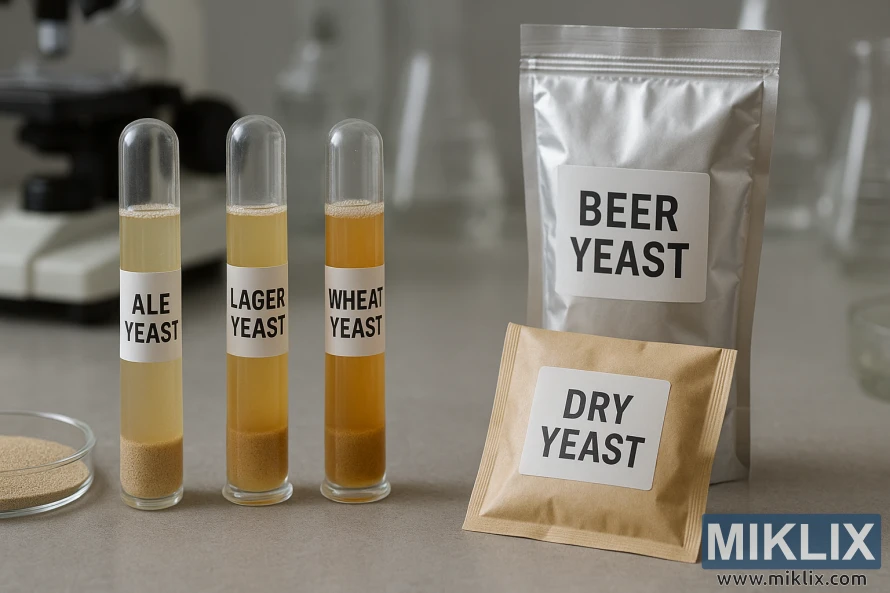Image: Yeast strains for homebrewing beer
Published: July 20, 2025 at 7:09:28 AM UTC
Last updated: September 27, 2025 at 12:52:21 PM UTC
Test tubes of ale, lager, and wheat yeast with dry yeast samples and packages arranged in a sterile lab, highlighting brewing yeast varieties.
In a clean, softly lit laboratory setting that blends scientific precision with the artisanal spirit of brewing, a curated display of yeast strains and fermentation tools offers a glimpse into the microscopic world that powers beer production. The scene is arranged with care and clarity, inviting the viewer into a space where biology meets craft. At the forefront, three transparent test tubes stand upright, each meticulously labeled: ALE YEAST, LAGER YEAST, and WHEAT YEAST. These tubes contain liquid cultures, their contents subtly different in hue, ranging from pale amber to golden yellow. At the bottom of each tube, a layer of sedimented yeast cells has settled—a visual cue of active cultures, dense with potential and ready to be pitched into a batch of wort.
The labels are crisp and utilitarian, suggesting a controlled environment where strains are tracked and studied. Each yeast type represents a distinct brewing tradition: ale yeast, known for its fruity esters and top-fermenting behavior; lager yeast, cooler and slower, producing clean, crisp profiles; and wheat yeast, often associated with hazy, aromatic beers like hefeweizens, rich in clove and banana notes. The test tubes themselves are clean and sterile, their clarity emphasizing the purity and viability of the cultures within. They stand like sentinels of fermentation, each one a vessel of transformation.
Beside the tubes, a small glass petri dish holds a scattering of dry yeast granules. These tiny beige particles are uniform and compact, a freeze-dried form of yeast that can be rehydrated and activated with ease. Their presence adds a tactile element to the scene, contrasting the liquid cultures with a more shelf-stable alternative. The granules glisten slightly under the ambient light, hinting at their biological potency despite their dormant appearance. This dish bridges the gap between lab and kitchen, between experimentation and execution.
To the right, two sealed packages labeled BEER YEAST and DRY YEAST rest on the counter. One is a sleek silver pouch, likely vacuum-sealed to preserve freshness, while the other is a brown, paper-like packet that evokes a more rustic, perhaps organic presentation. These commercial yeast products suggest accessibility and variety, offering brewers options tailored to different styles and preferences. Their packaging is practical yet distinct, reinforcing the idea that yeast selection is both a technical decision and a creative one.
In the background, slightly out of focus, a microscope and assorted glassware hint at the analytical side of brewing. The microscope, though blurred, anchors the scene in microbiology, reminding us that yeast is a living organism—one that can be studied, cultivated, and optimized. The glassware, clean and minimal, adds to the sterile ambiance, suggesting a space where precision matters and contamination is carefully avoided. The neutral tones of the background, paired with the soft lighting, create a calm and focused atmosphere, ideal for both research and hands-on brewing.
Altogether, the image is a quiet celebration of yeast—the invisible engine behind fermentation, the unsung hero of beer. It captures the diversity of strains, the contrast between liquid and dry forms, and the intersection of science and craft. Whether viewed by a seasoned brewer, a curious student, or a fermentation enthusiast, the scene offers insight into the complexity and beauty of brewing. It’s a reminder that behind every pint lies a world of biology, chemistry, and choice, and that even the smallest organisms can have the biggest impact on flavor, aroma, and experience.
The image is related to: Yeast in Homebrewed Beer: Introduction for Beginners

